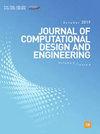生成式人工智能与建筑设计:使用本地特征训练模型实现外墙的早期逼真渲染可视化
IF 4.8
2区 工程技术
Q1 COMPUTER SCIENCE, INTERDISCIPLINARY APPLICATIONS
引用次数: 0
摘要
本文阐明了一种利用生成式人工智能来开发基于本地特征的替代建筑设计方案的方法。人工智能技术的发展日益引起 AEC-FM(建筑、工程、施工和设施管理)行业的兴趣。尤其是在设计的早期阶段,"可视化 "作为一种加强项目交流的手段,其重要性日益凸显。本研究旨在通过借鉴多种文本和图像,提高设计初期获取设计图像的便捷性。它开发了一个额外的训练模型,通过将生成式人工智能应用于建筑物的外立面设计,生成与当地特征产生共鸣的各种设计方案。城市和地区的地域特征是指城市和地区作为一个特定区域被识别和认可的能力。在城市和地区景观的各种视觉元素中,建筑物的正面可能对人们的审美感知和对当地环境的整体印象起着重要作用。这项研究提出了一种超越传统的三维建模和渲染工具的方法,即在商业建筑改造中考虑到这种地方特征,随时推导出可供选择的设计方案。在最初的建筑设计过程中,这种方法可以在设计交流阶段提高经济和时间效率。在本研究中,拟议方法的补充训练模型的实施和使用过程如下:1) 使用开放源街景资源从目标区域收集图像数据,并进行预处理以转换为可训练格式;2) 准备文本数据以与预处理图像数据配对;3) 使用不同的文本提示和图像进行额外训练和结果测试;4) 通过拟议应用方法研究的结果,确定使用额外训练模型生成反映所收集地点特征的建筑立面图像的能力。这样就能生成融合地区风格和不同建筑设计要求的备选设计方案。本研究中实施的训练模型可通过权重调整和提示工程等多种方法加以利用,生成更多的设计参考图像。本文章由计算机程序翻译,如有差异,请以英文原文为准。
Generative AI and Building Design: Early Photorealistic Render Visualization of Façades using Local Identity-trained Models
This paper elucidates an approach that utilizes generative AI to develop alternative architectural design options based on local identity. The advancement of AI technologies has increasingly piqued the interest of the AEC-FM (architecture, engineering, construction and facility management) industry. Notably, the topic of ‘visualization’ has gained prominence as a means for enhancing communication related to a project, especially in the early phases of design. This study aims to enhance the ease of obtaining design images during initial phases of design by drawing from multiple texts and images. It develops an additional training model to generate various design alternatives that resonate with the identity of the locale through the application of generative AI to the façade design of buildings. The identity of a locality in cities and regions is the capacity for the cities and regions to be identified and recognized as a specific area. Among the various visual elements of urban and regional landscapes, the front face of buildings may play a significant role in people's aesthetic perception and overall impression of the local environment. The research proposes an approach that transcends the conventional employment of three-dimensional modeling and rendering tools by readily deriving design alternatives that consider this local identity in commercial building remodeling. This approach allows for financial and temporal efficiency in the design communication phase of the initial architectural design process. The implementation and utilization of the proposed approach's supplementary training model in this study proceeds as follows: 1) image data are collected from the target area using open-source street-view resources and preprocessed for conversion to a trainable format; 2) textual data are prepared for pairing with preprocessed image data; 3) additional training and outcome testing are performed using varied text prompts and images; 4) the ability to generate building façade images that reflect the identity of the collected locale by using the additional trained model is determined, as evidenced by the findings of the proposed application method study. This enables the generation of design alternatives that integrate regional styles and diverse design requirements for buildings. The training model implemented in this study can be leveraged through weight adjustments and prompt engineering to generate a greater number of design reference images, among other diverse approaches.
求助全文
通过发布文献求助,成功后即可免费获取论文全文。
去求助
来源期刊

Journal of Computational Design and Engineering
Computer Science-Human-Computer Interaction
CiteScore
7.70
自引率
20.40%
发文量
125
期刊介绍:
Journal of Computational Design and Engineering is an international journal that aims to provide academia and industry with a venue for rapid publication of research papers reporting innovative computational methods and applications to achieve a major breakthrough, practical improvements, and bold new research directions within a wide range of design and engineering:
• Theory and its progress in computational advancement for design and engineering
• Development of computational framework to support large scale design and engineering
• Interaction issues among human, designed artifacts, and systems
• Knowledge-intensive technologies for intelligent and sustainable systems
• Emerging technology and convergence of technology fields presented with convincing design examples
• Educational issues for academia, practitioners, and future generation
• Proposal on new research directions as well as survey and retrospectives on mature field.
 求助内容:
求助内容: 应助结果提醒方式:
应助结果提醒方式:


